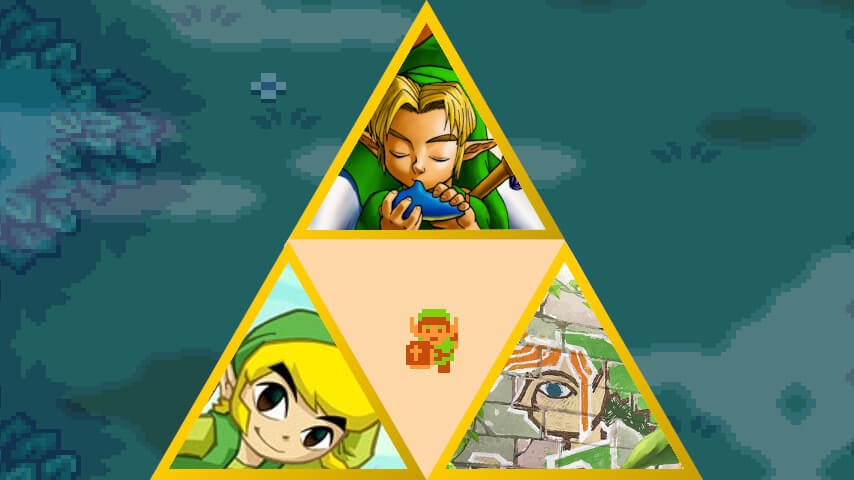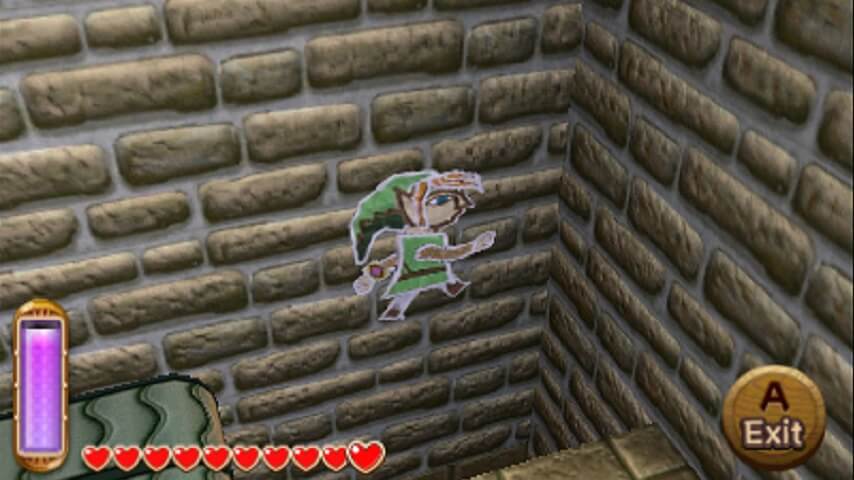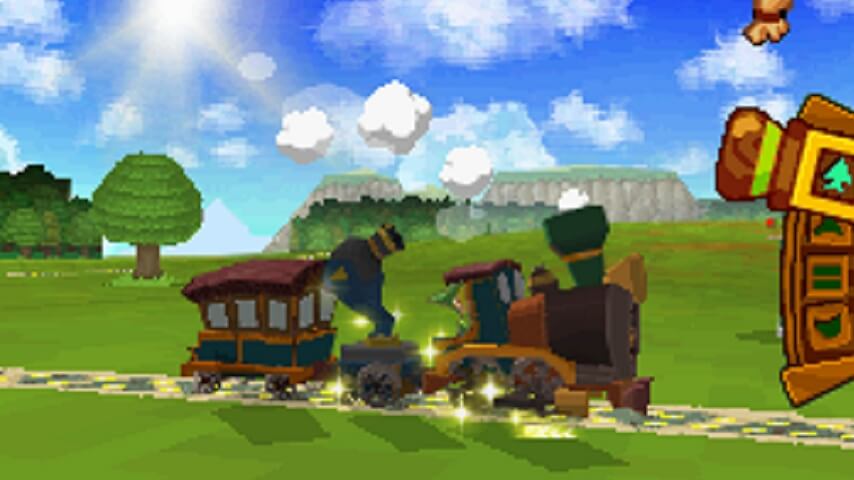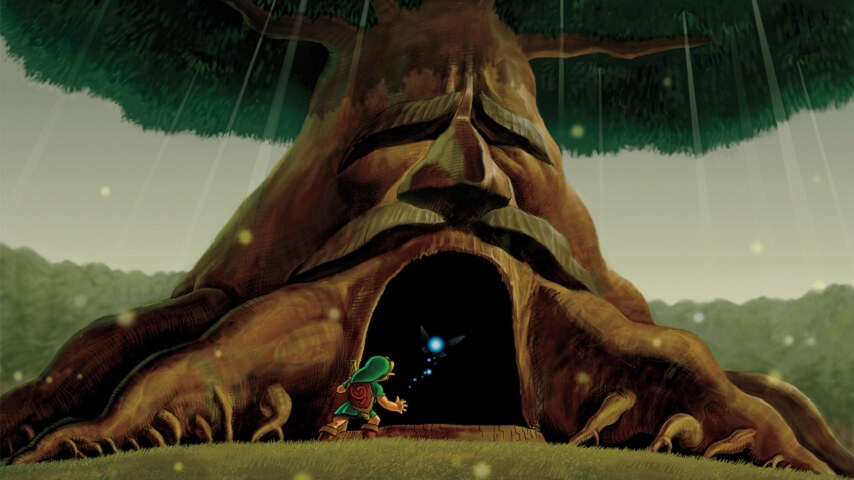We pick the best, worst, and weirdest games from four decades of The Legend Of Zelda
In honor of Echoes Of Wisdom arriving this week, we pick three exemplars from The Legend Of Zelda: Its Best, Worst, and Weirdest games
Original artwork and screenshots: Nintendo
The very first screen of the original The Legend Of Zelda is video games’ most clarifying mission statement. Green, rocky mountains. Barren plain space between them with paths leading east, west, and north. Little elf in a green tunic and a pitch black cave offset to the left of the northern passage. It’s a statement limited in its interpretations: you can go anywhere you want but you can’t go back. And given that it’s the darkest object on the screen—the thing that immediately draws your eye—you should probably go into the cave.
Of course, if you don’t you’ll die pretty fast. Damn rock-spitting octopuses all over the place.
At its most plush and satisfying, Zelda—which gets a new installment in this week, in the form of Switch title Echoes Of Wisdom—sets you down in a fantasy landscape that feels open and vast but places subtle, powerful boundaries to direct you through the quest. Shigeru Miyamoto, the foundational Nintendo creator that founded the series, defined this central tenet long before other creators like Eiji Aonuma took over its stewardship. “I wanted to create a game where the player could experience the feeling of exploration as he travels about the world, becoming familiar with the history of the land and the natural world he inhabits,” Miyamoto said in a 1994 interview.
The series’ better entries leave you feeling like you truly are the hero—whether it’s of Time, Wind, Wild, Sky, or whatever noun its developers focused on for each entry’s distinctive mechanical and story theme. If you’ve cobbled together some kind of insane stone skateboard out of trees, rocks, and historical debris to soar over a chasm in Tears Of The Kingdom, or resurrected a long-dead flying chicken in Link’s Awakening to do the same, you know that feeling well.
Those aforementioned thematic tweaks to the formula—time travel, controlling the elements, etc.—have only made the core challenge of cultivating spatial and narrative balance even more difficult. “The flip side of doing something new, however, is that Zelda was a game where we were very concerned whether players would understand what they were supposed to do,” Miyamoto explained in that same interview. “And once we decided there’d be riddles and puzzles in Zelda, that carried a lot of anxiety with it as well. Some of the puzzles are quite difficult to solve, after all.” Despite its reputation as the very archetype of adventure video games, Zelda has failed frequently at balancing direction and the illusion of freedom.
That balance—in world, in the feel of moving through that world, in cultivating a lasting impression of change in consequence as you do so—defines the series’ Best, Worst and Weirdest entries.
The Best: A Link Between Worlds
2013 handheld title A Link Between Worlds—trapped as it is to the largely abandoned Nintendo 3DS and its asymmetrical dual-screens—might seem like an unlikely candidate for being the best Zelda ever made. Direct sequel to Link To The Past, one of the most celebrated and influential games of the early ‘90s? That recreates its world almost identically to make a new game in a softer, more muted color palette? What sounds like a recipe for nostalgia-baiting soft-reboot territory is in practice the most Zelda game the series has ever produced, recontextualizing the already successfully established physical boundaries of its predecessor. And it does so by both expanding your freedom to explore within those borders, and using the visual language of passed-down legends—murals—to metamorphose those subtle directions on how to move through the game.
Continuity has never been a priority in Zelda, to its lasting benefit. Part of the fun is that these are “legends,” a story you’re hearing after the fact that’s been contorted by the passage of time and its retelling. Each one vaguely takes place before or after the others, with “official” timelines popping up fitfully over the decades. Heroes and villains like the eponymous princess, her attendant Impa, the hero Link, and the sinister pig-thief-monster-demon-overlord-tragic-figure Ganon are more like archetypal figures than fully realized characters, as is the totemic Triforce, a creation foundation stone they often fight over. That Link Between Worlds follows Link To The Past doesn’t really matter in terms of story, but it gains so much by incorporating the physical trappings of passed down hero narrative right into the premise of the game.
Things kick off almost immediately when you fire it up, with yet another green-tunic-rocking Link immediately called to adventure. This time a giant paint brush-wielding evil wizard named Yuga—looking like a gothy failed cross-clone experiment mixing David Bowie and Adam Duritz’s DNA—is trying to trap descendants of Hyrule’s ancestral protectors in paintings so he can resurrect Ganon and gain control of the Triforce to rule over Lorule, a shadowy mirror to Princess Zelda’s verdant Hyrule. After learning about Hyrule’s heroic history via murals in Zelda’s castle, and receiving his mission to stop Yuga, though, Link gets turned into a painting himself. He survives this transformation, now a living piece of mythic storytelling able to cling to most flat surfaces and navigate otherwise impossible paths in the game’s fields, mountains, and labyrinthine dungeons.
Never overwhelming but also never overly prescriptive, Link Between Worlds blooms almost immediately. While the game directs you to an initial, simple dungeon to familiarize you with the flow of exploration, the game quickly gives you free rein to explore both Hyrule and Lorule, with few narratively-restricted gates between you and progress. Everywhere you go, there’s something immediately in your line of sight that seems inaccessible but encourages you to use whatever’s at your disposal to get there, even if the solution’s as simple as clinging to the wall as a painting to slip through iron bars.
Rather than restrict the discovery of new tools—Link always accumulates a mix of novel and recurring tools like bombs to clear walls, a bow and arrow, etc.—you’re given the option to rent nearly all of them from Rovio, a rabbit mask-wearing weirdo who seems unusually eager to lend a hand. If you have the cash, you can unlock almost the full set of tools needed to explore every inch of the game. In Link To The Past, the series established a habit of explicitly building its dungeons around items found in them, which made successive entries feel rigid and predictable. Link Between Worlds didn’t explicitly do away with the format—you still need the Tornado Rod, a little propeller that can create a breeze to lift objects and propel you into the air, to get through the House of Gales. But the feeling of agency you have by choosing to get the rod at your leisure and bring it back to the dungeon enhances that feeling of ownership in the adventure.
Over the years, as Zelda expanded alongside new gaming technology, it became harder and harder for its creators to let you out into the world without over-explaining things. Entries like Twilight Princess and Skyward Sword dull their pace with grueling collectathons—find the spirit orbs, gather the lights—to force familiarity with the environment. The beloved Breath Of The Wild and Tears Of The Kingdom on Switch give you near total freedom to explore their wide-open countrysides and full access to those items you can use to solve puzzles, but it flattens the illusion of progress.
In Link Between Worlds, when you collect enough rupees to permanently own your items without worrying about losing them if you die, or discover hidden monsters that can permanently upgrade them, there’s a sense of forward thrust and achievement absent in those modern classics. (Spending five hours trudging through a shadowy underworld just to find a hat that barely protects you in combat until you spend another five hours harvesting materials to upgrade it kind of bogs things down.) Momentum and freedom are equally prioritized in Link Between Worlds, each one propelling you through an invisible funnel to saving both Hyrule and Lorule from Yuga. It never feels like you’re stuck on rails—unlike the very literal case of the worst Zelda game ever made.
Worst: Spirit Tracks
It’s telling that 2009’s The Legend of Zelda: Spirit Tracks, for Nintendo DS, and Link Between Worlds shared not just Eiji Aonuma, the series’ executive producer for the past quarter century, but multiple key design staff. Shiro Mouri was the programmer and assistant director on both, alongside designer Koji Takahashi. Playing both games back to back, you get the real sense that Link Between Worlds’ successes are the result of recognizing that something went very, very wrong with Spirit Tracks.
One of the joys of navigating in Zelda, since its inception, has been the discovery and novelty of its vessels. Rafts, horses that really love wind instruments, sunfish-style sailboats possessed by long-dead monarchs; there’s always a cool way to travel the countryside as you’re directed towards the ultimate confrontation with some apocalyptic force. Spirit Tracks, theoretically at least, seems like an excitingly bizarre push forward for what’s traditionally been a series built on bucolic fantasy imagery. Train! And not just a delightfully steam punky train, but a train whose tracks crisscrossing Hyrule are what has sealed away the ancient evil Malladus. In execution, not only does placing a Zelda game on literal rails arrest whatever feeling of real exploratory freedom is core to the series, the adventure’s momentum screeches to a terminal halt.
Not only does the train and its inherent restrictions further push Zelda into a more explicitly linear path—you’re inevitably trapped on a prescribed route as you explore the countryside, even as it expands—but it causes you to repeat tedious actions over and over again. Every time Spirit Tracks introduces you to a novel scenario, like directing a massive suit of enchanted armor possessed by Princess Zelda’s disembodied ghost, you’re inevitably shunted back into a plodding trudge to the next small dungeon or town. The incredibly restricted number of items and tools in the game reflect how restrictive the entire experience is. Sure, Link gets a whip, but the opportunities to transform locomotion and navigation challenges are almost non-existent. The broader world is stuck on tracks, and the most variety you’ll get is having to delicately transport chickens or pottery between towns. Over and over again, because doing it too fast or while not carefully avoiding raiders, will make you start all over. Nothing says you’re the romantic driver in charge of your adventure like being a glorified Amtrak conductor.
Strange that a train, a classically swift form of transportation, should result in the slowest and most tedious Zelda in addition to being the most constrained. That lack of velocity and agency sours the experience so completely that it’s difficult to really enjoy how adorably strange the game often is. Tapping the DS’ low-tech touch screen to pipe out notes on a little pan flute or enjoying that aforementioned whip (which is also a snake) taps into the whimsical weirdness that has defined the series’ distinctive spin on Tolkien-esque fantasy from the jump. And none are weirder than what was, at one time, considered the series’ cultural pinnacle.
The Weirdest: Ocarina Of Time
When your series has produced not one. but half-a-dozen games viewed as epochal benchmarks in an entire medium, it’s tough to contextualize precisely why they were individually so important in their cultural moments. 1998’s The Legend of Zelda: Ocarina Of Time for Nintendo 64 is at least superficially easy to give its due, as it was one of the first expansive three-dimensional adventure games ever made. By the time it came out, work like Super Mario 64 (which shared a significant number of key creators with Ocarina) and Tomb Raider had laid the groundwork for a vocabulary of designing games in a world considering the Z-axis.
Ocarina, however, felt transformative. Even though its world of mountains, fields, towns, and lakes was just as segmented as those in Super Mario 64—and arguably smaller and more contained than those in Tomb Raider—Ocarina truly did feel seamless in its presentation of a coherent world. The shift in perspective wasn’t what made Ocarina weird at the time, or what’s kept it so utterly weird even now. It was the game’s willingness to build a world on failure that makes it such an outlier.
Not darkness, mind you. Zelda’s worlds have always thrived on a sense of the macabre. Monsters trying to desanguinate Link in Zelda II; the doomsday threat of a leering moon falling from the sky and light, mask-born body horror in Ocarina’s direct sequel Majora’s Mask; even the post-decline austerity of Breath Of The Wild’s wilderness; Zelda games are always marked by a twinge of melancholic storytelling and supernatural threat. Only Ocarina Of Time, though, upends its entire world and your passage through it because Link and Zelda were dumb kids who screwed up.
The first act of the game is in large part a retread of Link To The Past, a series of lightly complex dungeons leading one to the next that acclimate you to the different types of navigational challenges you’ll be facing as you go. Each one rewards you with one of three gewgaws that will let you wield the Master Sword, a fixture of the series that lets Link beat down whatever evil faces him. Only, in Ocarina Of Time, getting the Master Sword is what lets Ganon win in the first place. The first act is a manipulation, before you’re let out until the wider world, aged up seven years, and forced to consider the landscape not just as a place to explore, but a series of mistakes you were indirectly the cause of.
What’s so strange about this is how demotivating it is to see this ruined future Hyrule. I was so distraught the first time I played Ocarina Of Time, I was convinced I’d done something wrong in the game. Bad endings are a thing! Clearly it’s Link’s fault, and therefore my fault, that a dragon is eating the mountain Gorons, that all the fish people are frozen in magic ice, and Hyrule Castle Town is riddled with what appear to be ambulatory wooden corpses. I’m the one who got the sword. That the world is full of physical indicators of this mistake, one leading into the next as Link works to mend the world, is a markedly different motivator than simply discovering a world challenged by sinister forces the hero had nothing to do with.
The cumulative effect of Ocarina Of Time’s fuller adventure, defeating Ganon and freeing Princess Zelda in that wrecked future, before reverting to a safer childhood, is less one of triumph and achievement than it is of relief. “Thank god that’s over with” is a more complex emotional experience than “I’ve conquered evil and returned home,” but it’s no less powerful. And while all of Ocarina’s successors have arguably been more cosmetically strange—Link becoming a wolf in Twilight Princess, or gaining the ability to build functional mechs out of the physics-based detritus of Tears Of The Kingdom—none have rung as enduringly haunting as Ocarina Of Time.
That aftertaste, at least in its creator’s mind, is what actually binds the series together. “[Above] intra-series continuity it’s far more important to me that the player is left with a satisfying ‘aftertaste’ once the experience is over,” said Miyamoto a year after Ocarina’s release. “For those who played the original Zelda and Link To The Past, I would ask you to compare how you felt when those games ended, with how Ocarina Of Time felt when you finished it. If you focus on that ‘aftertaste,’ then I think you’ll understand: ‘Ah, yes, I see how it’s a series.”” It’s the world in each game that creates that flavor, though, for better and worse.

